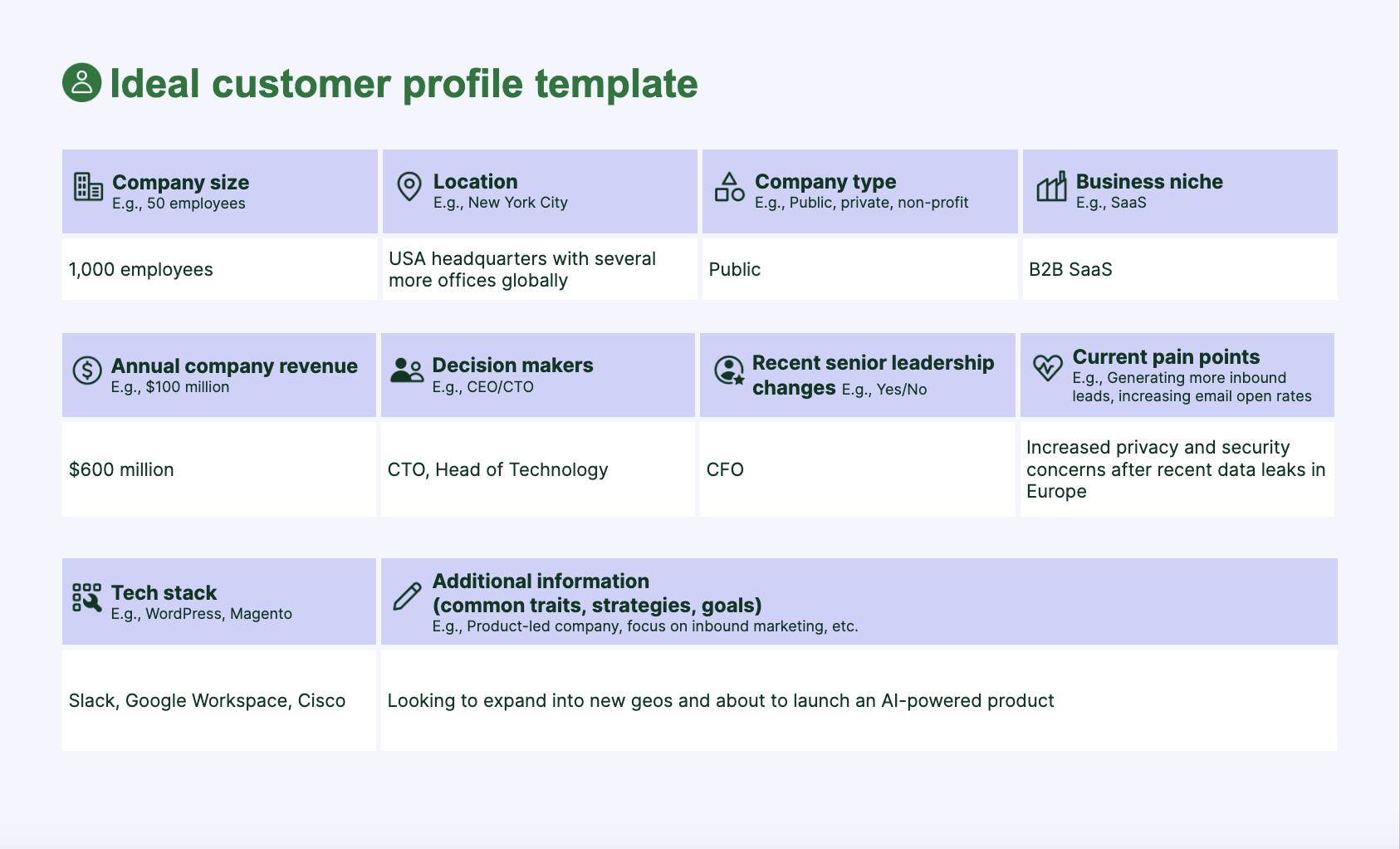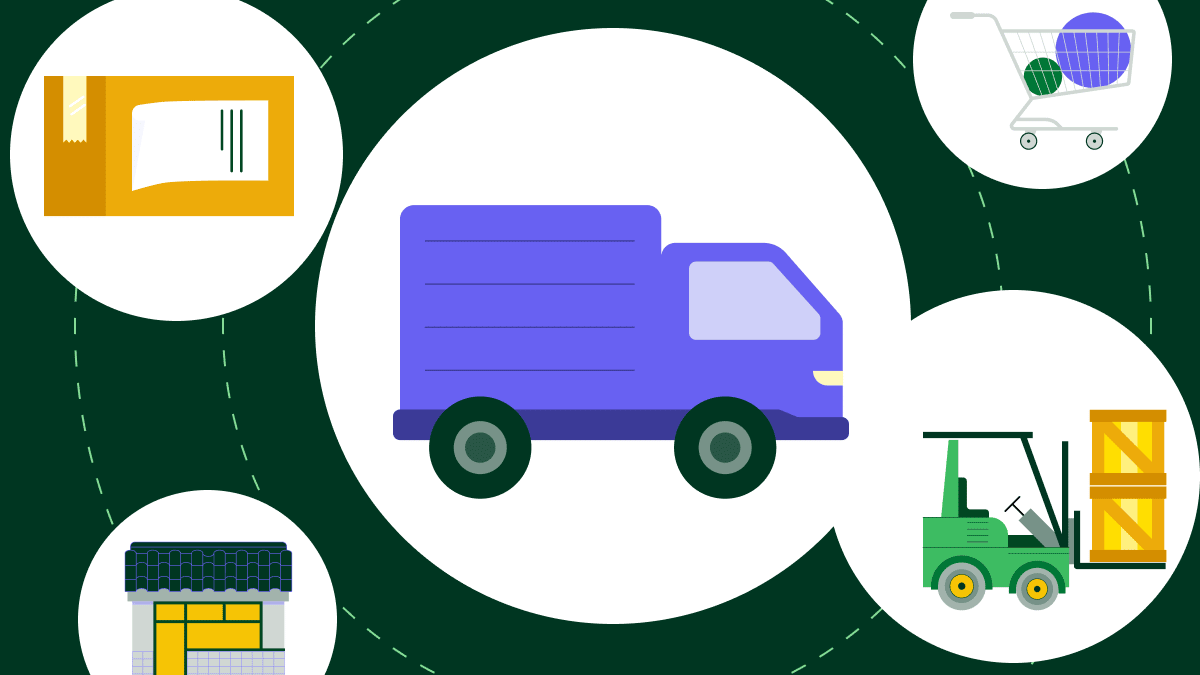Every customer adds unique value to your business. Some customers convert quickly, refer you to friends and spend more with your business over time.
Understanding these customers can help you attract more people like them, speeding up your sales cycles, bringing in more business and contributing to greater customer lifetime value.
In this article, you’ll learn how to create an ideal customer profile so you can allocate resources to pursue your best customers. We’ll also include an ideal customer profile template (which can also be used as an ideal client profile template) so you can create yours today.
What is an ideal customer profile?
An ideal customer profile (ICP) is a detailed description of your most valuable customers, including their demographics, firmographics and psychographics.
Customer demographics are population-defining statistics like age, race, gender or marital status.
Firmographics are like demographics, but for organizations. They include factors such as organization type, organization income level and organization industry.
Psychographics focus on behavioral characteristics. Psychographic data includes factors such as customer hobbies, spending habits and values.
An ICP characterizes the customers who are the best fit for your product or service.
It’s sometimes called an ideal client profile for agencies and businesses offering professional services.
Creating an ICP involves understanding and documenting factors like:
The region where your ideal customers are located
The industry or industries your ideal customer operates in
The company size in terms of revenue, employees or other relevant metrics
The needs and pain points the customers face that your product can address
The role of the decision maker that would decide to buy your product
Ideal customer profile example and template
The ideal customer profile definition sounds simple, but ICPs can look different from company to company and industry to industry. What’s important is that yours contains the information you need to distinguish your most valuable customers from the others.
Here’s an example of a completed ICP. In this example, the ideal customer is a B2B SaaS company focused on cybersecurity.

This could also be an ideal client profile example if the business offers professional services to businesses. Make sure you focus on the highest-value sales prospects – those that are more likely to convert and become loyal customers.
Download your ideal customer profile template
ICP vs. target customer
ICP is sometimes confused with “target customer” but there is a difference between the terms.
A target customer describes any person, group or company you hope to sell to. Together, your target customers make up your potential customer base.
In contrast, ICPs describe the best customers – those who spend the most over their engagement with you, cost the least and like your product best.
| Target Customer | ICP |
Describes any person, group or company that you hope to sell to. | Describes your most valuable customers. |
ICP vs. buyer persona
ICPs are also not the same as buyer personas, although they’re related.
ICPs are high-level and usually relevant to businesses selling to other businesses (B2B). They include firmographic characteristics that describe the perfect organization or company that would buy your product or service.
On the other hand, a buyer persona is a semi-fictional representation of an individual within the ICP who would buy your product or service. It often includes demographic information, job titles, challenges, motivations, goals and personal preferences.
Here is an example of a buyer persona:

ICPs and buyer personas help teams understand who their customers are and how to help them achieve their tasks. A buyer persona visualizes this information by creating an imaginary person representing their customers’ interests. Making decisions can be easier when teams have a specific person in mind to cater to.
ICPs are similar, and sometimes a buyer persona is crafted from this profile, but they focus exclusively on the highest-value customers.
In B2B (businesses that sell to other businesses), an ICP would comprise a business, but the buyer persona could represent the key stakeholder with decision-making power at the company.
In B2C (businesses that sell straight to consumers), there’s less need for both an ICP and buyer persona.
| Buyer Persona | ICP |
| A fictional representation of a person who would buy your product | Describes only your best, most valuable customers |
Used by both B2B and B2C companies | Often used by B2B companies to represent a prospective company |
Why do you need an ideal customer profile?
ICPs help you understand who your best customers are and what they need, so you can better attract and retain them.
ICPs can be powerful: One survey by TOPO (acquired by Gartner) found that companies with robust ICPs had 68% higher account win rates than companies without them.
Here are some ways an ICP can help you convert and retain customers better:
Better quality leads. An ICP helps you build your list of prospects. You can quickly filter potential prospects to find only companies with the characteristics you’re looking for. High-quality lead generation gives your sales team a better chance to convert.
Prioritize the most suitable accounts. From that list of leads, an ICP helps your teams decide which accounts to invest time in. You can score leads based on how closely they match your ICP and spend more resources on the ones that score most highly, which makes your sales process more efficient.
Enhanced marketing. Good marketing sends the right message to the right person at the right time. With a well-defined ICP, you truly understand your target audience, their pain points, preferences and the sales channels they use. It helps your marketers craft messages that resonate deeply.
Stronger retention. When you understand your ideal customer’s needs, you can tailor your product and customer journey to suit them. They’re more likely to see your product’s value and be happy with it. Greater customer satisfaction translates to repeat business.
An ICP ultimately helps you focus your prospecting, lead prioritization, marketing and customer experience so they’re more effective.
How to create a detailed ideal client profile
Developing an ICP isn’t complicated, but it requires a deep understanding of your customers.
Rather than make assumptions about your ideal customers, try to learn their actual preferences and needs. That typically means collecting data on your ideal customers and using it as the foundation for your profile. For businesses offering professional services, this is called “client profiling”.
Here’s what a robust ICP development process could look like.
Step 1: Identify your best current customers
The key question in this stage is, “Who are our best existing customers?”
To answer this question, start by creating a set of criteria that matter to your business. Some examples include:
Customer lifetime value (CLV). One critical factor is revenue. Your best customers will contribute the most revenue over their relationship with you.
Customer service cost. Consider costs also. Some high-value customers cost a lot to service. Your ideal customers will be those who don’t require significant support or time from the customer success team.
Referrals. Some customers become advocates of your product. These can be especially valuable, even if their CLV isn’t high.
Sales cycle length. You may be interested in reducing the length of your sales cycle. If so, consider adding short sales cycles to your list of criteria for the ideal customer.
There are other sales metrics you might consider. You may be especially interested in customers with a high conversion rate or a low acquisition cost.
Your best customers might be those who report high satisfaction scores or present opportunities for upselling and expansion. Each business is unique, so determine which criteria matter most to you.
Once you have your criteria, use customer data to locate customers who meet them.
Sourcing this customer data is easy with a customer relationship management (CRM) tool like Pipedrive. You can quickly filter and sort to find your customers with high CLVs, low support interactions, the most referrals and the shortest sales cycles, or whichever other criteria matter to you.

Step 2: Identify common traits
Once you know your top customers, try to understand what they have in common. This step involves identifying patterns, common traits, characteristics, goals and pain points among your top customers.
Consider firmographic factors like their company size, the type of company and their industry, but also reflect on motivations and needs, too:
Why did they buy your product?
What problems were they trying to solve?
What are their “jobs to be done” (the tasks they need to complete, also known as JTBD)?
What other options did they consider?
Why did they choose yours?
Questions like these can give you a clear understanding of the factors driving your best customers and what they have in common.
Tip: To investigate and find out what motivates your best customers, you may need to research. Consider conducting customer surveys, customer calls, interviews or focus groups to better understand your top customers and identify commonalities.
Step 3: Define and refine your ICP
After analyzing your data and finding common themes, you’re ready to create your ICP.
Compile your findings to create a profile. This profile should focus on the business, but you can also include details about the job roles of key decision-makers or influencers, their business goals and the challenges they face.
Once you’ve created a detailed ICP, put it in a shareable document so your teams can access it quickly.
Now, ask for feedback. Ensure the profile resonates with the teams that know your customers best: sales, marketing, customer success and customer support. Revise the document using their feedback.
Step 4: Re-evaluate regularly
An ICP is a living document. Market trends shift, your business evolves and your product improves over time. With those changes, you may begin reaching new customers and your ideal client profile may change.
That’s why it’s good practice to re-evaluate your ICP periodically. Regular reviews of your ICP ensure that it stays relevant and continues to be a useful tool for your business.
Consider re-evaluating your ICP once or twice a year or more frequently if your business growth is rapid or your market changes quickly. If you notice a decline in the effectiveness of your sales and marketing strategies or your customer churn rate is increasing, that might be a sign that it’s time to revisit your ideal client profile.
How an ICP can help you attract and close more customers
An ICP is a strategic tool. You can use it to convert more customers and reduce churn. Here’s how your teams and stakeholders can use your ICP across different areas of your business.
Sales
ICPs can be powerful sales tools. Here are some ways that sales teams can use them.
Build high-quality prospect lists. Use ICP characteristics to create a list of high-value prospects. For example, set up your website Chatbot with Pipedrive’s LeadBooster add-on to identify and engage ideal customers as they browse your website.
Score leads. Use your ICP to score leads and identify ideal customers before they convert. The closer a lead is to your ideal customer, the more time your sales team can spend on activities to engage them.
Cold outreach. Cold emailing and calling can still be effective if done properly. Rather than cold call everyone in your target market, use your ICP to narrow your list and identify the right companies to contact. Then use your ICP to develop your email or cold call script.
Tailor engagement. Your ICP can also help you choose the right approach. When you understand your ideal customer, you can use the best communication channels, style and sales pitches.
Sales teams can use the ICP to spend their time on the right customers and make the sales cycle more efficient.
Marketing
ICPs can be extremely valuable to marketers. Here’s how your marketing team can use them.
Understand pain points. Most companies go through a fairly comprehensive research process to understand their best customers. That process usually uncovers useful insights for marketers about customer pain points.
Develop buyer personas. Buyer personas are often about individuals in specific roles who work at your ideal customer companies. Knowing your ICP gives marketers the details they need to generate more accurate buyer personas.
Sharpen copy. When your marketing team better understands your customers’ pain points and buyer personas, they can write compelling sales copy that hits just right. Customer interviews can also help marketers talk about your product and the problems it solves in your customers’ own words.
Inform content strategies. Your ICP can help your marketing team know what content to produce. They’ll be able to understand the needs of your most valuable customers and create the most useful content.
ICPs help you to execute targeted marketing campaigns that fill your sales pipeline with high-quality leads.
Customer success
Customer success teams are typically in charge of reducing churn and creating expansion revenue. They can leverage ICPs to help customers get the most value from your product.
Identify churn risk. ICPs can help identify customers who don’t align well with the ICP and could be at risk of churn. Recognizing this early can trigger proactive engagement to improve their experience and retention.
Upsell and cross-sell. ICPs can provide insights into which customers might be most receptive to upselling or cross-selling opportunities. Understanding the ideal customer's needs and growth potential empowers Customer Success teams to recommend additional products, services or seats.
Locate customer advocates. ICPs can guide Customer Success teams to identify potential customer advocates or brand ambassadors. Customers who closely align with the ICP and are highly satisfied with your product or service are likelier to provide testimonials, case studies or referrals.
Applying an ICP can make it easier for Customer Success teams to support customers, reduce churn and maximize customer lifetime value.
Customer support
Customer Support teams, like Customer Success teams, can also use ICPs in several ways to provide superior support.
Tailor support responses. Understanding the characteristics of an ideal customer can guide support teams to tailor their responses. This may involve using specific language, tone or technical detail that matches the ideal customer’s knowledge and preferences.
Prioritizing support tickets. ICPs can help your helpdesk prioritize support tickets. You may prioritize customers who closely align with the ICP, as their satisfaction and retention are crucial for the business.
Improve self-service resources. With insights from the ICP, support teams can optimize self-service resources such as FAQ pages, knowledge bases and automated chatbots. They can create resources that align with the needs of the ideal customer.
An ICP can help your customer service team structure their service to meet the needs of your most valuable customers.
Product management
Product management teams are responsible for building a product that your customers love. They can use the ICP to help them make informed product decisions.
Prioritize features. Product managers can use ICPs to guide their product roadmap. They can choose to prioritize the features your best customers request or build new strategic features to attract more of your ideal customers.
Testing usability. Product managers can ensure they include participants that match the ICP when conducting usability tests or customer interviews. That way, they verify that your product meets the needs of customers who match the ICP.
Design onboarding flows. ICPs can guide the development of more effective onboarding experiences. Understanding an ideal customer’s preferences, roles and needs allows product teams to build onboarding processes that help them quickly get value out of your product.
Ultimately, ICPs can give your product team a north star around which to make prioritization and development decisions.
Executives
Ideal Customer Profiles (ICPs) can be powerful strategic tools for executive teams. Here are some ways they can serve for planning.
Business strategy. ICPs can guide high-level business and sales strategy by highlighting the most valuable customer segments and why. This could shape decisions around where to spend development resources, marketing spending, geographical expansion, etc.
Company vision and mission. ICPs can influence the broader company vision and mission. By understanding who the company serves best, leaders can craft a vision and mission that resonates with these customers and aligns the entire company around serving them effectively.
Staff recruitment and training. Knowing the needs and expectations of your ICP can inform the skills, attitudes and knowledge your team needs to serve them best. This can guide hiring decisions and inform employee training programs.
ICPs can help executive teams focus their decision-making on serving their ideal customers more effectively and driving growth.
Final thoughts
An ICP can be an incredibly valuable tool. It can give your organization better visibility into why your best customers choose your product, the problem you solve for them and the key characteristics they share.
Those insights are useful across your organization, not just for your sales team. By focusing on the most promising target accounts, your business can better attract, satisfy and retain the customers who contribute most to your bottom line.
Better understand your customers with our Ideal Customer Profile template. Use this template to help your teams attract and retain the highest-value customers.







